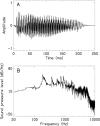The Relationship between Contralateral Suppression of Transient Evoked Otoacoustic Emission and Unmasking of Speech Evoked Auditory Brainstem Response
- PMID: 36405487
- PMCID: PMC9668434
- DOI: 10.1055/s-0042-1742774
The Relationship between Contralateral Suppression of Transient Evoked Otoacoustic Emission and Unmasking of Speech Evoked Auditory Brainstem Response
Abstract
Introduction Several studies have shown that efferent pathways of the auditory system improve perception of speech-in-noise. But, the majority of investigations assessing the role of efferent pathways on speech perception have used contralateral suppression of otoacoustic emissions as a measure of efferent activity. By studying the effect of efferent activity on the speech-evoked auditory brainstem response (ABR), some more light could be shed on the effect of efferent pathways on the encoding of speech in the auditory pathway. Objectives To investigate the relationship between contralateral suppression of transient evoked otoacoustic emission (CSTEOAE) and unmasking of speech ABR. Methods A total of 23 young adults participated in the study. The CSTEOAE was measured using linear clicks at 60 dB peSPL and white noise at 60 dB sound pressure level (SPL). The speech ABR was recorded using the syllable /da/ at 80 dB SPL in quiet, ipsilateral noise, and binaural noise conditions. In the ipsilateral noise condition, white noise was presented to the test ear at 60 dB SPL, and, in the binaural noise condition, two separate white noises were presented to both ears. Results The F0 amplitude of speech ABR was higher in quiet condition; however, the mean amplitude of F0 was not significantly different across conditions. Correlation analysis showed a significant positive correlation between the CSTEOAE and the magnitude of unmasking of F0 amplitude of speech ABR. Conclusions The findings of the present study suggests that the efferent pathways are involved in speech-in-noise processing.
Keywords: auditory brainstem responses; efferent pathways; otoacoustic emissions; speech.
Fundação Otorrinolaringologia. This is an open access article published by Thieme under the terms of the Creative Commons Attribution-NonDerivative-NonCommercial License, permitting copying and reproduction so long as the original work is given appropriate credit. Contents may not be used for commecial purposes, or adapted, remixed, transformed or built upon. ( https://creativecommons.org/licenses/by-nc-nd/4.0/ ).
Conflict of interest statement
Conflict of Interests The authors have no conflict of interests to declare.
Figures




Similar articles
-
Speech-ABR in contralateral noise: A potential tool to evaluate rostral part of the auditory efferent system.Med Hypotheses. 2019 Nov;132:109355. doi: 10.1016/j.mehy.2019.109355. Epub 2019 Aug 8. Med Hypotheses. 2019. PMID: 31604162
-
Speech-in-noise perception ability can be related to auditory efferent pathway function: a comparative study in reading impaired and normal reading children.Braz J Otorhinolaryngol. 2020 Mar-Apr;86(2):209-216. doi: 10.1016/j.bjorl.2018.11.010. Epub 2019 Jan 28. Braz J Otorhinolaryngol. 2020. PMID: 30772249 Free PMC article.
-
Contralateral suppression of transient otoacoustic emissions and sentence recognition in noise in young adults.J Am Acad Audiol. 2012 Oct;23(9):686-96. doi: 10.3766/jaaa.23.9.3. J Am Acad Audiol. 2012. PMID: 23072961
-
Role of Active Listening and Listening Effort on Contralateral Suppression of Transient Evoked Otoacousic Emissions.J Audiol Otol. 2017 Apr;21(1):1-8. doi: 10.7874/jao.2017.21.1.1. Epub 2017 Mar 30. J Audiol Otol. 2017. PMID: 28417101 Free PMC article.
-
The First Jerger Lecture. Contralateral suppression of otoacoustic emissions: an index of the function of the medial olivocochlear system.Otolaryngol Head Neck Surg. 1994 Jan;110(1):3-21. doi: 10.1177/019459989411000102. Otolaryngol Head Neck Surg. 1994. PMID: 8290299 Review.
References
-
- Scharf B, Magnan J, Chays A.On the role of the olivocochlear bundle in hearing: 16 case studies Hear Res 1997103(1-2):101–122. - PubMed
-
- Bell A, Jedrzejczak W W. Muscles in and around the ear as the source of “physiological noise” during auditory selective attention: A review and novel synthesis. Eur J Neurosci. 2021;53(08):2726–2739. - PubMed
-
- Cody A R, Johnstone B M. Acoustically evoked activity of single efferent neurons in the guinea pig cochlea. J Acoust Soc Am. 1982;72(01):280–282. - PubMed
-
- Zheng X Y, Henderson D, McFadden S L, Hu B H.The role of the cochlear efferent system in acquired resistance to noise-induced hearing loss Hear Res 1997104(1-2):191–203. - PubMed
LinkOut - more resources
Full Text Sources
Miscellaneous

